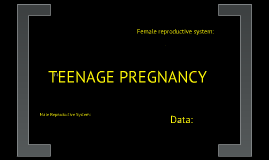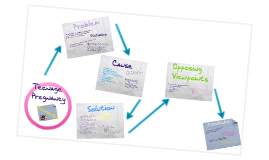Teenage Pregnancy
Transcript: Teenage Pregnancy Introduction Dr.Boesky is explaining how teenage pregnancy can be harmful to teens, children, and society. I have researched statistics, problems, causes and solutions of teenage pregnancy. Teenage pregnancy is a problem in our society today because it affects everyone, and we need to know what causes this problem so we, as individuals and as a whole, can work towards stopping it. First, I will tell you why teenage pregnancy is a problem. Then I will continue by explaining the causes and possible solutions. Finally, I will address why teenage pregnancy is wrong. Problem According to Gale Opposing Viewpoints, an online database for issues, teenage pregnancy is an issue today. Statistics Before the age of eighteen, 56% of women and 73% of men have had sexual intercourse. 63% of teenagers have used a condom when having sexual intercourse and 17% used birth control a month before engaging in sexual activities. About 10% (1 million) of teenagers in the United States become pregnant, which is about 1 in every 8 births. 33% of these teenagers abort their babies. 14% go through a miscarriage, and the last 52% go through child birth. Of the 52% of teenagers that go through child birth, 90% of them keep their children. The other 10% put their babies up for adoption. 87.9% of pregnant teens were taught about HIV or AIDS. Affects, teen mothers, the children, and the teens parents. This also affects you. Almost everyone in this room could have a baby before the age of 20. People such as friends, girlsfriends, and sisters can also get pregnant. You would have to watch loved ones go through a difficult pregnancy. Cause Population No Contraception No HIV or AIDS worry Hard to get contraception Risks Peer pressure No guidence Drugs and alcohol Media According to Admin, an author on roevwade.org, a website for both sides of an argument, on February 16, 2011, this affects the society as well. Experts believe that the rates will keep rising until it reaches the record high. In 1990, there were 116.9 pregnancies per 1,000 women. In 2006, there were 71.5 pregnancies per 1,000 women. If the rates keep increasing at this rate, the record high will be reached by 2030. 18 years from now, most of us will have our own kids. As a result, our kids will be affected by this problem. Solution Each member of the audience can understand that both boys and girls are responsible for avoiding teenage pregnancy. Teens need to resist peer pressure and talk openly with parents or other adults about sexual intercourse. If you are sexually active, you need to use both birth control and condoms. This will give you a 98% chance of not getting pregnant. Adults need to talk with teenagers who come to them and provide them with information and programs that these teens can go to. They also need to explain the consequences on sexual intercourse and how it could affect their life. Government Communities Parents These solutions will: lower teenage birth rate limit peer pressure limit parents worry help the economy limit the amount of people in poverty Opposing Viewpoints Teens become pregnant because: No contraception Lifestyle Peer pressure Media Teenage pregnancy affects everyone in a negative way. Teen mothers Children Parents Audience Conclusion By recognizing this issue and knowing the causes, we can stop it and allow more teenagers to live better lives. What you need to do: Teens- resist peer pressure, talk to parents, and use contraception adults- talk to teens and provide them with answers and information More people would live happier, healthier, and safer lives without teenage pregnancy. Teenage pregnancy is an issue in the world today and we need to all come together to change it. (cc) photo by jimmyharris on Flickr (cc) photo by Metro Centric on Flickr (cc) photo by Metro Centric on Flickr

















